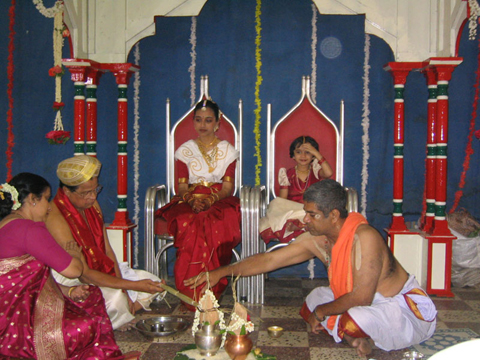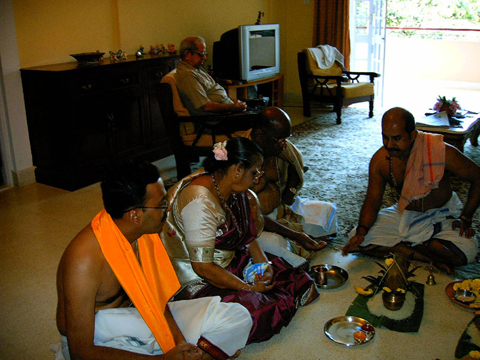Kanya Agamana
Kanya Agamana The maternal uncle of the bride brings the bride to the mantap by holding her hand. Malasamparana - exhanging of garlands. The bride and the groom are made to stand of small heaps of rice grains, the boy facing east and the girl facing west. A cloth is held separating both of them. The priest then recites the sacred mantras invoking the ancestors of both the families. The bride and the groom proclaim their love and acceptance of each other by bestowing a garland on one another. This is the first step in their unity and the exchange symbolises the unification of their hearts. They sprinkle rice grains on one another.

Anu's maternal uncles Dev Maam and Ananth Maam accompanying her to the mantap.

Dev Maam and Anu

The priest performs the rituals

The priest performs the rituals

Anu putting the garland on me.

Me putting the garland on Anu
Kanya Daan
KanyaDaan - Giving away of the Bride In this ceremony, the bride is given away in marriage. The bride's parents give their daughter as a divine offering to the groom to fullfill the obligations that are social, ethical and moral. The bride's parents offer prayers to their Gurus and elders and seek their blessings. They wait for the auspicious moment, the Lagna Muhurtha which is predetermined by the priest. At this moment, the hands of the bride are placed over the groom. The bride's mother pours sanctified water and milk over the joined hands and that of the bride's father. The couple are advised to be strong and righteous and to show affection for each other's families. They accpet each other as companions for life and agree to live together most cordially and in perfect harmony. They pray that their hearts be blended and beat in unison.

Anu's father placing her hand on mine.

Me throwing rice (akshada) on Anu

Me applying Kumkum to Anu

Mantap Pooja
The bride applies Kumkum and Sandalwood paste to the 4 pillars of the Mantap and offers prayers. Next comes the wearing of the Dharemani , a black bead ornament by the bride. This ornament is considered very sacred by a married woman and she wears it throughout her life as a mark of her being married.
Hymns from the Sri Suktha which is 5000 years old are recited before wearing this sacred ornament. At the same time 2 head ornaments, Basinga and the Mangal Sutra and the marriage saree are worshipped. The bridegroom is tied with the Basinga and the Aarti is waved before him. He is then respectfully brought to the Mantapa.

Anupama applying Sandalwood and Kumkum to the Mantap

My aunt and other relatives getting ready

Anupama's aunts and other relatives

Anupama with her niece Neha. Anupama's parents are performing the rituals

Me, Sachin and Anupama's parents
Mehndi
Mehndi is the traditional art of adorning the hands and feet with a paste made from the finely ground leaves of the henna plant. The term refers to the powder and paste, and the design on the skin, as well as the party or ceremony. Henna is a small shrub called hawsonia inermis, and is also know as Henne, Al-Khanna, Al-henna, Jamaica Mignonette, Mendee, Egyptian Privet, and Smooth Lawsonia. Henna grows in hot climates and is found in India, Pakistan, Malaysia, Persia, Syria, Egypt, Morocco, Sudan and other North African, Asian and Middle Eastern countries. The leaves, flowers, and twigs are ground into a fine powder, then mixed with hot water. Various shades are obtainable by mixing with the leaves of other plants, such as indigo. Tea, coffee, cloves, tamarind, lemon, sugar, and various oils are also used to enhance the colour and longevity of design.
Henna is used in celebrations of betrothals, weddings, births, circumcisions, religious holidays (similarly for Hindus, Muslims, Jews, Christians and other religions) and National festivals. A bride whose family has little money wears her mehndi in place of ornate gold jewellery. It is said that when a bride has mehndi done for her wedding, the darker the design, the more her mother-in-law loves her. A good deeply-coloured design is a sign of good luck for the marital couple. It is common for the names of the bride and groom to be hidden in the mehndi design; and the wedding night cannot commence until the groom has found the names. A bride is not expected to perform any housework until her wedding mehndi has faded. While much of the symbolism of mehndi designs are being lost some examples remain. The peacock, which is the national bird of India, the lotus flower, and an elephant with a raised trunk, which is a symbol of good luck, are all popular images.
The images below are the Mehndi work done on my cousin sisters hands.
Unfortunately, I don't have pictures of Anupama's Mehndi. You can see a bit on
the first picture below.

Anupama (in front), my cousin's wife Anuradha and my cousin sister Maya

This image and the rest are images of the mehndi on the hands of my cousin sisters.





Naandi
This is a simple but important ritual consisting of a 'puja' (prayer) and is performed ten days prior to the actual wedding ceremony. The 'puja' is performed separately in both homes. The purpose being to negate the ill effects of any deaths in the family so that the marriage ceremonies may carry on without any obstacles.
A 'kalesha' (silver pot) is placed on a small heap of rice with a coconut on it, which in turn is placed in front of the deity and blessed. The 'kalesha' will remain in the puja room till all the wedding ceremonies are completed.

Naandi Pooja being performed by the priest (Bhatji) and my relatives.

My mother and me at our home in Bangalore.

Me, with a few of our relatives.
Next Victim
We are on the lookout for a nice bride for this guy whose images are shown below. Think we need better images than this. Also he will get rid of the cockroach growing on his face.

My brother Sachin

Osama Bin Sachin